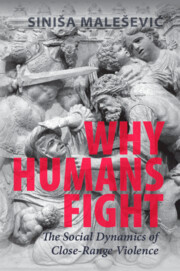Book contents
- Why Humans Fight
- Why Humans Fight
- Copyright page
- Dedication
- Contents
- Acknowledgements
- Introduction
- 1 The Body and the Mind
- 2 Profiting from Fighting
- 3 Clashing Beliefs
- 4 Enforced Fighting
- 5 Fighting for Others
- 6 Avoiding Violence
- 7 Social Pugnacity in the Combat Zone
- 8 Organisational Power and Social Cohesion on the Battlefield
- 9 Emotions and Close-Range Fighting
- 10 Killing in War
- 11 The Future of Close-Range Violence
- Conclusion
- Appendix Methodology and Data Collection
- References
- Index
5 - Fighting for Others
The Networks of Micro-Bonds
Published online by Cambridge University Press: 29 September 2022
- Why Humans Fight
- Why Humans Fight
- Copyright page
- Dedication
- Contents
- Acknowledgements
- Introduction
- 1 The Body and the Mind
- 2 Profiting from Fighting
- 3 Clashing Beliefs
- 4 Enforced Fighting
- 5 Fighting for Others
- 6 Avoiding Violence
- 7 Social Pugnacity in the Combat Zone
- 8 Organisational Power and Social Cohesion on the Battlefield
- 9 Emotions and Close-Range Fighting
- 10 Killing in War
- 11 The Future of Close-Range Violence
- Conclusion
- Appendix Methodology and Data Collection
- References
- Index
Summary
The principal aim of this chapter is to explore the social context of fighting for other people. The traditional instrumentalist accounts emphasise that individuals are self-preservers who are unlikely to fight for others unless they are forced or induced to do so by genetic, material, or symbolic benefits. Hence for many cognitive evolutionary psychologists sacrificing oneself for others is possible only if such acts will increase one’s inclusive fitness, that is, the direct or indirect ability of an individual organism to pass on its genes to the next generation. For rational choice theorists collective action is always rooted in self-interest and one will fight for others on the assumption that others will do the same, thus enhancing the possibility that shared action will bring about greater benefit for all. Nevertheless, recent studies have questioned these well-established views by indicating that biology and instrumental rationality largely play a marginal role in the context of close-range violence. More important are emotions and moral ties as they impact substantially on one’s decision to fight for others. Many individuals develop strong networks of micro-solidarity which motivate different forms of collective action in the context of violent encounters. In this chapter I analyse when, how, and why individuals fight for others. The focus is on the dynamics of social pugnacity. I argue that one’s willingness to fight is a contextual phenomenon shaped by specific ideological and organisational logic. Nevertheless, despite its temporal and spatial variability, micro-group solidarity is a universal practice that underpins nearly all durable violent conflicts. In other words, fighting for others is a foundation of social pugnacity. The first part of the chapter traces the evolutionary trajectory of human sociability and looks at the structural transformation of micro-bonding in different historical contexts. The second part briefly explores the social and physical dynamics of micro-solidarity in the context of close-range fighting. The final, and longest, part analyses the workings of micro-level solidarities in the fighting practices of the three very different armed forces – American volunteers in the Spanish Civil War, Indian soldiers in the First World War, and members of the Wehrmacht in the Second World War.
Keywords
- Type
- Chapter
- Information
- Why Humans FightThe Social Dynamics of Close-Range Violence, pp. 129 - 160Publisher: Cambridge University PressPrint publication year: 2022

